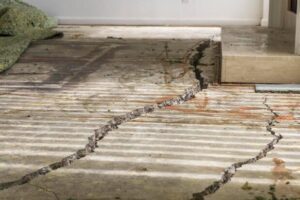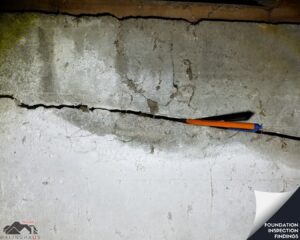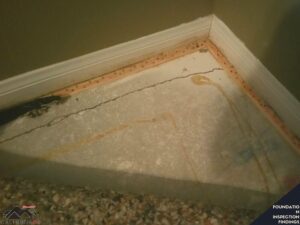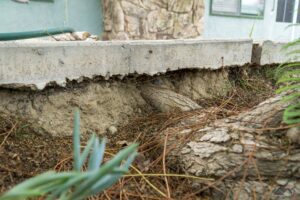Cracks in concrete are eye sores to say the least. Repairing them can also leave you with a less than appeasing look.
Repairing concrete cracks is just that. You are going to fill in the crack with some sort of approved material depending on a couple different characteristics.
In this article, we will discuss the different characteristics of concrete cracks as well as the proper means to repair them depending on these characteristics.
Here are the top 5 characteristics of concrete cracks.
- Where is the crack located?
- What is the width of the crack?
- What was the concrete initial design?
- Is the crack misaligned?
- What caused the crack to occur?
Where is the crack located?
Depending on where the crack has occurred will always determine the type of repair that is needed to ensure that the concrete crack is repaired properly. You wouldn’t use the same crack repair method on a sidewalk slab that you would also use on a crack on a home’s foundation.
Sidewalk slabs tend to carry minimal loads and they are designed as such. Most of the time sidewalk slabs do not have any rebar or steel mesh in them. This is done to keep the installation costs down as well as the assumption that there will not be a lot of movement or loads on the concrete.
The repair methods for sidewalk and patio cracks are typically one of 2 options.
1. Crack Sealing. This is done typically with a flexible sealing material. The main objective of the crack sealing is to stop any moisture or water from entering through the crack and speeding up the process of additional movement out of the crack.
2. Remove and Replace. If the cracks are too large or if the overall final appearance is a priority. It would make more sense to remove that portion of the concrete and re-pour it with more steel added. This can also be recommended if the concrete slab is very thin and sealing it would not be the best fix for it.
What is the width of the crack?
Size does matter! A crack that is wider than 1/2″ will need to be addressed differently than a crack that is at 1/32″, or a hairline crack.
Cracks that have a larger width are going to be repaired with either carbon fiber staples or some sort of steel staple to help prevent the crack from getting any wider. If the crack is really large than removing and replacing that section of the crack would be recommended.
When a removal and replacement is recommended for a crack, the contractor will need to saw cut at minimum of 18″ on each side of the crack. The concrete is removed, new base material is installed, and rebar is doweled into the remaining slab. After that has occurred the cracked area is re-poured and finished.
If cracks are on a smaller scale, the crack can typically be routed out with a crack chaser, then cleaned, and then injected with a structural epoxy.

What was the concrete initial design?
If you don’t have a good plan that is worth executing than the outcome will more than likely fall below your expectations. That statement is 100% true when it comes to concrete designs.
You wouldn’t use the same design to pour a sidewalk slab as you would to pour a foundation footing. Concrete, depending on where it is located, will have different design requirements. Slabs that don’t have any steel or mesh within the design will not be as capable to sustain their integrity as a design that does incorporate the use of steel rebar or mesh.
The same will go with cracks that occur in the concrete. A concrete slab or footing that has steel, will typically be designed to carry some sort of load. Many interior home slabs and foundation footings and stem walls will have steel within them.
Cracks that occur on concrete that has steel will almost always be some sort of epoxy injection repair. These cracks need to be filled so moisture does not come into contact with the steel.
If water does come in contact with the steel, it will cause it start to rust. Once the steel within the concrete starts to rust, it will also expand and cause spalling of the concrete or additional cracking to relieve the pressure of the steel expansion.
The picture below shows a footing that has experienced the rebar expanding and causing a crack that runs right where a piece of rebar is located.

Is the crack misaligned?
Misaligned cracks can mean there is more than just the concrete cracking. If the crack is misaligned it can mean that you have a section of your home or slab that is either heaving or settling.
Repairing just the crack in this situation would not be beneficial and would ultimately be a bandaid repair. The crack has occurred for a reason and you would first need to address the reason so the crack does not reappear.
We have seen many homes that have had all sorts of “fillers” added to the cracks within the concrete slab. We have seen things such as drywall mud to them being filled in with additional concrete.
Once the cause of the misaligned crack has been remedied, you can then fix the crack with either a gravity fill method, epoxy injection, or a removal and replacement if the crack does not realign itself during the repair of the cause.

What caused the crack to occur?
This is the number one question that needs to be answered to have a successful crack repair project. If the cause is not addressed than you are going to more than likely be doing the crack repair work again in the future.
Hairline cracks in concrete can occur without a significant cause. They can be caused by a pour water to concrete mix when the concrete was poured. Or they can be caused by the speed at which the concrete cured. These cracks are pretty insignificant and typically are not damaging to the integrity of your concrete.
Misaligned cracks are the big ones to look for, for the cause. Cracks that have become misaligned are the effects of a portion of the slab or footing moving.
This movement can either be from heaving, which is when the soil or tree roots expand under the concrete and push it up. Or it can be caused by settlement, which is when the concrete starts to sink into the soil because of a variety of reasons.
If heaving occurs, the repair methods are pretty limited on the repairs. It is typically a removal and replacement of the damaged area. Once the concrete has been removed, you will also want to remove the cause.
If the cause is the soil, you will need to remove at least 4″ of soil and then put back a base of compacted rock or sand. If the cause is from tree roots, you will need to remove the concrete and then remove all of the roots that are in the area. You will also want to remove the root source from the exterior of the home as well.

If the concrete has experienced settlement, you will need to confirm the area and then have a proper method to lift and stabilize the effected area. Most of the time, when the cause of the concrete settlement has been lifted back into place, it will also realign the previously misaligned crack.
Once the cause has been fixed, you can then typically utilize an epoxy material to repair the cracks.
Learn more about Offset cracking.
If you would like to learn more about foundation repair and the signs and symptoms, we invite you to download the Foundation Repair Guide.







